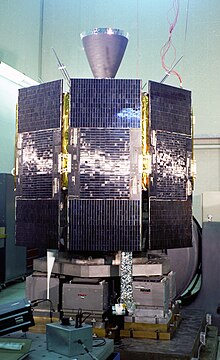

The Timation satellites were conceived, developed, and launched by the United States Naval Research Laboratory in Washington, D.C. beginning in 1964. The concept of Timation was to broadcast an accurate time reference for use as a ranging signal to receivers on the ground.
On 31 May 1967, the Timation 1 satellite was launched. This was followed by the Timation 2 (NRL-PL 169) satellite launch in 1969.
In 1973 the U.S. Navy Timation and the Air Force System 621B navigation system (known as the DNSS - Defense Navigation Satellite System) are consolidated by the Deputy Secretary of Defense.

Two more advanced Timation satellites are launched. NTS-1 - Navigation Technology Satellite (Timation 3) is launched in 1974, while NTS-2 (Timation 4) is launched in 1977.
The results of this program and Air Force Project 621B formed the basis for the Global Positioning System (GPS). The Navy's contribution to the GPS program continued to be focused on ever more accurate clocks.
History
There is a historical connection between accurate time keeping, navigation, and the Navy. In 1714, the British government passed the Longitude Act (see longitude prize) to create an incentive to solve the problem of navigation at sea. The solution, developed by John Harrison, was an accurate clock which could compare local time to Greenwich, England time. To this day, Coordinated Universal Time (UTC), the successor of Greenwich Mean Time (GMT), is the reference time for the planet, and in the United States, the official time for the Department of Defense (DoD) is kept by the United States Navy at the U.S. Naval Observatory in Washington, D.C. This is kept in synchronization with the official civilian time reference maintained by National Institute of Standards and Technology (NIST) and contributes to the International Atomic Time.
Satellites
| Satellite | Launch | Launch Pad | Launcher | NSSDC ID | |
|---|---|---|---|---|---|
| Timation 1 | 31 May 1967 | SLC 2W | Thor-DM21 Agena-D | 1967-053E | with Poppy 5A, 5B, 5C, 5D; Calsphere 3, 4; NRL-PL 150B and OPS 5712 |
| Timation 2 | 30 September 1969 | SLC 1W | Thorad-SLV2G Agena-D | 1969-082B | with Poppy 6A, 6B, 6C, 6D; Tempsat 2; SOICAL Cone, Cylinder; Weston; NRL-PL 176 |
| NTS-1 (Timation 3) | 14 July 1974 | SLC 3W | Atlas F PTS | 1974-054A | |
| NTS-2 (Timation 4) | 23 June 1977 | SLC 3W | Atlas F SGS-1 | 1977-053A |
See also
References
- ^ "Timation 1, 2". Gunter's Space Page. Retrieved 11 November 2024.
- ^ "Timation". www.astronautix.com. Retrieved 11 November 2024.
- ^ "GPS Timeline". 13 February 2010. Archived from the original on 13 February 2010. Retrieved 11 November 2024.
- ^ "NTS 1 (P73-3)". Gunter's Space Page. Retrieved 11 November 2024.
- ^ "NTS 2 (P76-4)". Gunter's Space Page. Retrieved 11 November 2024.
- R.L. Beard; J. Murray & J.D. White (1986). "GPS Clock Technology and the Navy PTTI programs at the U.S. Naval Research Laboratory" (PDF). pp. 39, 40. Archived from the original (PDF) on 6 June 2011. Retrieved 1 February 2009.
 This article incorporates text from this source, which is in the public domain.
This article incorporates text from this source, which is in the public domain.
- "NIST Time". NIST. 3 February 2010. Retrieved 10 June 2013.
 This article incorporates text from this source, which is in the public domain.
This article incorporates text from this source, which is in the public domain.
External links
- Timation Satellite Program (navy.mil) Archived 30 June 2008 at the Wayback Machine
- Who invented the Global Positioning System? (thespacereview.com)
- Range navigation using the Timation II satellite
| Satellite navigation systems | |
|---|---|
| Operational | |
| Historical | |
| GNSS augmentation | |
| Related topics | |
This article about one or more spacecraft of the United States is a stub. You can help Misplaced Pages by expanding it. |